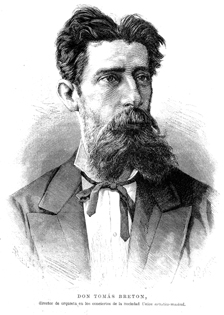<Back to Index>
- Physician Carl Friedrich Wilhelm Ludwig, 1816
- Composer Tomás Bretón, 1850
- Prime Minister of the United Kingdom William Ewart Gladstone, 1809
PAGE SPONSOR

Tomás Bretón (December 29, 1850 – December 2, 1923) was a Spanish musician and composer.
Tomás Bretón was born in Salamanca.
He gained renown as a result of the success of his zarzuela La verbena de la Paloma, although other works were also well received, including his óperas Los amantes de Teruel, based on the eponymous legend, and La Dolores. After his death, his extensive output was generally forgotten. His career spanned the majority of the musical trends of the period of the Restoration (1875 - 1923): Conservatorium Director, reputed orchestral conductor, composer of óperas, zarzuelas, symphonic and chamber music.
He aimed to create a Spanish opera, which would form a basis for a national music. He not only expressed his ideas in his many writings, but also composed a series of works throughout practically his whole career which reflected them, from Guzmán el bueno (1876) to Tabaré (1913). His series of nine óperas, two of them in only one act, are an ambitious body of work for Spanish composers of his time. After a long polemic which delayed its première, Los amantes de Teruel (1889) amounted to its definitive consolidation, and was followed by proposals along very different lines, such as the Wagnerian in Garín (1892) for the Barcelona Liceo and the veristic in La Dolores (1894) for the Madrilenian Teatro de la Zarzuela. His last works, despite being tied to a strong nineteenth century tradition, contain undeniable interest, such as Raquel (1900), based on the famous romantic drama, Farinelli (1902), composed for the failed Teatro Lírico project, Tabaré (1913), set in America, and Don Gil de las calzas verdes (1914), based on a comedy by Tirso de Molina.
At
the same time, he approached the art zarzuela with unequal success. His
output, while less than that of his contemporaries Chapí,
Giménez and Fernández Caballero, is of great quality,
given the variety of genres which he tackled. He made several attempts
at composing in the zarzuela grande genre, both in a more traditional
line than previous generations in works such El campanero de Begoña (1878) and Los amores de un príncipe (1881), and at the end of the century in the Circo de Parish, with El clavel rojo (1899) and Covadonga (1901), where he adopted more modern procedures, within the limitations of the genre. His greatest fame came from the género chico, especially La verbena de la Paloma (1894),
one of the most famous zarzuelas of the Spanish repertoire, although he
later composed many others which were not as successful. On the other
hand, he wrote symphonic music with a singular insistence, at a time in
which in Spain, orchestral ensembles barely existed. He composed and
conducted numerous works for the Sociedad de Conciertos, of which he
was chief conductor from 1885 to 1890. A result of this were his three
symphonies (1872, 1883, 1905), revealing a strong assimilation of Beethoven's
compositional techniques. His most successful works were those with a
Spanish character, albeit in an Alhambristic vein – such as En la Alhambra (1887) – or a more danceable one, as in Escenas andaluzas (1894).
During his last years he composed various symphonic poems with a clear, nostalgic character, such as Los galeotes (1905) based on the famous Quixote episode, and Salamanca (1916) on popular themes from his native region. In the chamber music genre he has left us various works, including three quartets (one of which is published), as well as a trio and quintet, composed from markedly classical standpoints, influenced by the French world of Saint - Saëns. His wide musical knowledge led him to tackle many other genres such as song, including a song cycle based on Bécquer's rhymes (1886), which was followed by Las golondrinas, and the oratorio El Apocalipsis (1882) composed in Rome as one of the works written under the Academy scholarship requirements.
The prolific composer for the guitar Francisco Tárrega dedicated one of his greatest masterpieces, "Capricho Árabe", to D. Tomás Bretón.